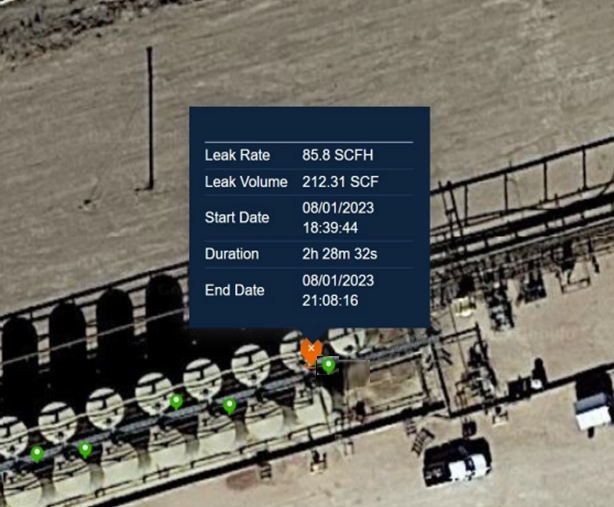High Productivity Cloud-based Software
The MethaneTrack™ system includes time-saving cloud software that automatically analyzes the data from the field to enable emissions abatement and emissions tracking.
Features
- High security software with robust data encryption, multi-factor authentication, and stringent access controls to ensure the protection of sensitive data.
- Automated leak analysis combining Close-Proximity, Continuous Monitoring™ architecture and Leak Source Isolation™ algorithms to determine the location and size of the emissions.
- User customizable alert settings to notify appropriate users of emissions.
- Automatic calculations of emissions volume for individual leaks as well as total emission volumes for individual sites, regions, countries, and the company.
- Features to separately track fugitive and operational emissions to improve understanding of emission types and aid operational improvements.
- Data output features to enable integration with existing enterprise tools.
- User configurable emissions reports enabling the system to integrate with existing processes and procedures.
Data Security
NevadaNano recognizes the sensitive nature of the emissions data and has employed state-of-the-art security features to keep your data protected, whether in transit or in storage. The list below summarizes the technology employed:
- Secure multi-factor authentication for secure login.
- Stringent Role Based Access Control to compartmentalize data.
- Data encryption to keep data safe in transit.
- Vulnerability and Penetration Testing to protect against intrusions.
- Continuous data backup to minimize data loss in the event of service interruptions.
- Data restoration testing to verify the effectiveness of backup procedures.
- Rigorous data destruction protocols in accordance with data retention policies.
Leak Source Isolation™ Technology: Providing the Location and Quantification of Emissions
One of the core technologies of MethaneTrack™ is the Leak Source Isolation™ (LSI™) software which provides location and quantification of all emissions. LSI™ algorithms combine gas readings from the endpoints with the wind speed and wind direction data to calculate the location and size of the emission using a technique called Inverse Plume Modeling. Inverse Plume Modeling is the process of tracking a gas reading at an endpoint back to the source using the wind direction. While a gas plume model uses wind information to calculate where the gas from a source will travel, Inverse Plume Modeling reverses this process using mathematical algorithms to track the gas readings from the endpoints back to the source using the wind vector.
After LSI™ calculates the location and size of the emission, MethaneTrack™ automatically alerts the operations team of the release and the emission rate, enabling the team to prioritize the abatement work and maximize the emissions reduction. The software displays the location of the leak to enable the repair team to quickly find the emission source, saving time and money.

